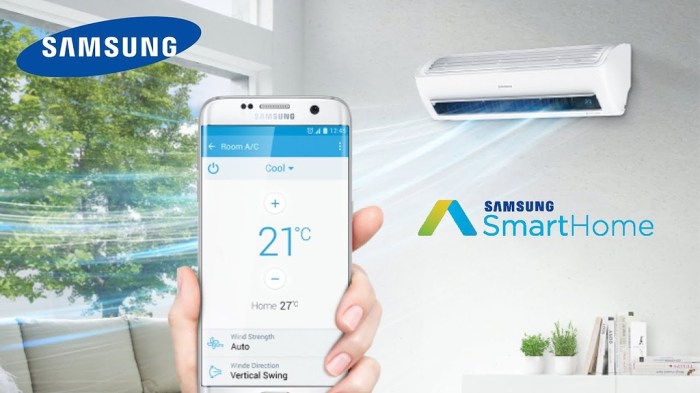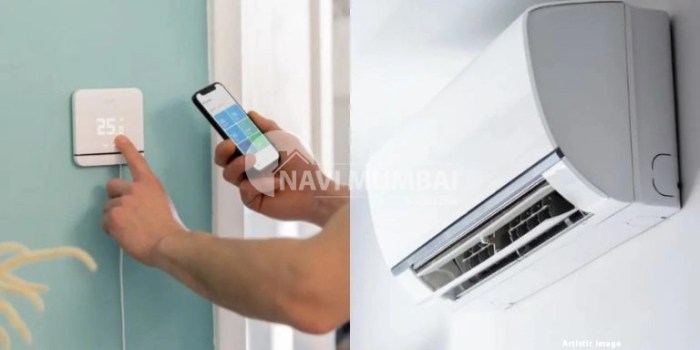Embark on a journey into the world of Smart ACs That Sync With Your Home Assistant, where convenience meets innovation. From controlling your air conditioner with a simple voice command to optimizing energy usage, this technology is reshaping how we interact with our homes.
Let's dive in and explore the seamless integration of smart ACs with home assistants.
Introduction to Smart ACs That Sync With Your Home Assistant
Smart air conditioners are revolutionizing the way we cool our homes by utilizing cutting-edge technology to enhance convenience and energy efficiency. These devices can be controlled remotely through a smartphone or a voice command, allowing users to adjust settings and monitor their AC units from anywhere.Home assistants, such as Amazon Alexa or Google Assistant, play a crucial role in creating a connected smart home ecosystem.
By integrating smart ACs with these home assistants, users can easily manage their cooling systems through voice commands, schedules, or automation. This seamless integration enhances the overall smart home experience and simplifies daily tasks.The benefits of having smart ACs that sync with home assistants are plentiful.
Not only do they offer convenience and flexibility in controlling the temperature of your home, but they also help save energy and reduce utility costs. By optimizing cooling schedules and settings based on occupancy or external factors like weather conditions, smart ACs can efficiently maintain a comfortable environment while minimizing energy wastage.
Features of Smart ACs
Smart air conditioners come with a range of features that enable seamless synchronization with home assistants, providing users with enhanced control and convenience in managing their indoor climate.
Remote Control Capabilities
- Users can remotely control their smart ACs through their home assistants, such as Amazon Alexa or Google Assistant, using voice commands or dedicated apps.
- With the ability to adjust temperature settings, fan speeds, and modes from anywhere, users can ensure their homes are comfortable before they even step inside.
Voice Integration for AC Settings
- Smart ACs are equipped with voice recognition technology, allowing users to change temperature settings, turn the unit on or off, or adjust fan speeds simply by speaking commands to their home assistant.
- Integration with voice assistants enhances the user experience by providing hands-free control and a more intuitive way to interact with the air conditioner.
Compatibility with Home Assistants
Smart ACs that sync with home assistants offer a seamless and convenient way to control your home's temperature with just your voice or a tap on your smartphone. Let's explore the compatibility of these smart ACs with popular home assistant devices.
Popular Home Assistant Devices
- Amazon Alexa
- Google Assistant
- Apple HomeKit
These are some of the most widely used home assistant devices that can sync with smart AC units, allowing you to control your cooling system effortlessly.
Setting Up and Configuring Smart ACs
The process of setting up and configuring smart ACs to work with different home assistants typically involves connecting the AC unit to your home Wi-Fi network and then linking it to your preferred home assistant app. This usually requires following the instructions provided by the manufacturer and enabling the necessary permissions on both the AC unit and the home assistant app.
Compatibility Comparison
| Home Assistant | Smart AC Compatibility |
|---|---|
| Amazon Alexa | Works with a wide range of smart AC brands |
| Google Assistant | Offers seamless integration with compatible smart AC models |
| Apple HomeKit | Supports selected smart AC units for a streamlined user experience |
While most smart AC units are designed to work with popular home assistant devices, it's essential to check compatibility before making a purchase to ensure a smooth setup process and optimal performance.
Automation and Customization
Smart ACs offer a high level of automation and customization, allowing users to create personalized settings for optimal comfort and energy efficiency. By integrating with home assistants, these smart devices can interact with other connected devices in the home, enhancing the overall smart ecosystem.
Programmable Settings
Smart ACs can be programmed to adjust settings based on user preferences, such as temperature, fan speed, and mode. Users can create custom schedules for different times of the day or week, ensuring that the AC operates efficiently based on their lifestyle and needs.
Integration with Other Smart Devices
One of the key benefits of smart ACs is their ability to interact with other smart devices through the home assistant. For example, the AC can automatically adjust its settings when a motion sensor detects that no one is in the room, helping to conserve energy.
It can also work in conjunction with smart blinds or lights to create a comfortable environment based on natural light levels.
Flexible Customization Options
Users have the flexibility to customize schedules and temperature settings according to their preferences. Whether they prefer a cooler temperature at night for better sleep or a warmer setting during the day, smart ACs can accommodate these adjustments seamlessly. Additionally, users can create personalized profiles for different family members, ensuring that everyone's comfort needs are met.
Energy Efficiency and Cost Savings
Smart ACs that sync with home assistants play a crucial role in enhancing energy efficiency and reducing costs for homeowners. By leveraging advanced technologies and automation features, these smart devices offer a range of benefits that contribute to a more sustainable and economical living environment.
Energy Efficiency Benefits
- Smart ACs utilize sensors and algorithms to adjust cooling settings based on occupancy and ambient conditions, optimizing energy consumption.
- Integration with home assistants enables seamless coordination with other smart devices, such as thermostats and occupancy sensors, for enhanced energy efficiency.
- Remote access and scheduling features allow users to control their AC units efficiently, preventing unnecessary cooling and reducing energy wastage.
Cost Savings Analysis
- By reducing energy consumption and optimizing cooling operations, smart ACs help lower electricity bills over time, leading to significant cost savings for homeowners.
- Automated energy-saving modes and adaptive cooling strategies ensure efficient usage of resources, translating into tangible financial benefits for users.
- Long-term savings from reduced energy consumption and optimized cooling processes make smart ACs a worthwhile investment for budget-conscious consumers.
Optimizing Energy Usage
- Set temperature thresholds and schedules based on occupancy patterns and personal preferences to minimize energy consumption without compromising comfort.
- Utilize energy-saving modes and features offered by smart ACs to reduce cooling load during off-peak hours and optimize energy usage throughout the day.
- Regularly monitor energy usage data provided by smart ACs and home assistants to identify potential areas for improvement and implement personalized energy-saving strategies.
Security and Privacy Considerations

When it comes to using smart ACs that sync with home assistants, it's essential to consider the security and privacy implications. As these devices collect data and connect to your home network, there are potential risks that need to be addressed to ensure your information and devices are secure.
Data Privacy Concerns
- Smart ACs may collect data on your usage patterns, temperature preferences, and even location information. This data could be sensitive and should be protected from unauthorized access.
- Ensure that the smart AC manufacturer has a clear privacy policy outlining how they handle your data and who has access to it. Opt for devices that prioritize user privacy and offer transparent data practices.
Security Measures
- Implement strong, unique passwords for your smart AC and home assistant devices to prevent unauthorized access. Avoid using default passwords and regularly update them for added security.
- Enable two-factor authentication whenever possible to add an extra layer of protection against unauthorized logins and breaches.
- Regularly update the firmware on your smart AC to patch any known vulnerabilities and ensure that your device is running the latest security protocols.
Enhancing Security in Connected Homes
- Segment your home network to create separate zones for smart devices like smart ACs, ensuring that they are isolated from other critical devices like computers or smartphones.
- Consider using a virtual private network (VPN) to encrypt your network traffic and protect your data when accessing your smart AC remotely.
- Monitor your smart AC's activity and set up alerts for any unusual behavior, such as unauthorized access attempts or changes in settings, to quickly address security concerns.
Wrap-Up

In conclusion, Smart ACs That Sync With Your Home Assistant offer a glimpse into the future of home automation. With benefits ranging from energy efficiency to enhanced comfort, the possibilities are endless. Embrace the convenience and control that smart ACs bring to your living space.
FAQ Overview
How do smart ACs sync with home assistants?
Smart ACs use Wi-Fi connectivity to communicate with home assistants, allowing users to control them remotely through voice commands or smartphone apps.
Which popular home assistant devices are compatible with smart ACs?
Popular devices like Amazon Alexa, Google Assistant, and Apple HomeKit can sync seamlessly with smart ACs, offering a range of functionalities.
Can smart ACs be programmed to adjust settings automatically?
Yes, smart ACs can be programmed to adjust temperature settings based on user preferences, creating a personalized and comfortable environment.
How do smart ACs contribute to energy efficiency?
Smart ACs optimize energy usage by adjusting cooling levels based on real-time data, leading to potential cost savings and reduced environmental impact.


